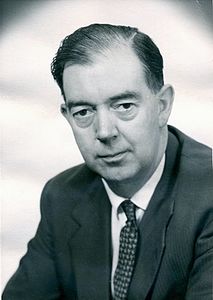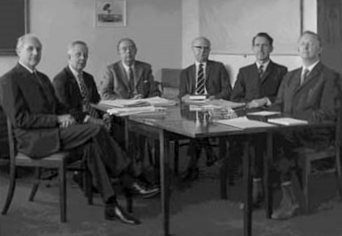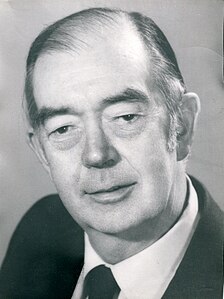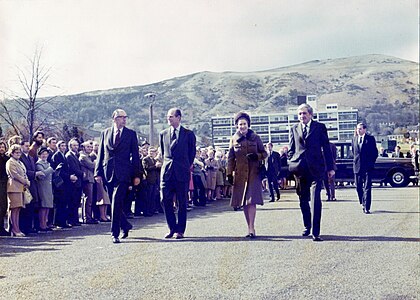John Robert Mills: Difference between revisions
Commenting on submission (AFCH 0.9) |
Rewording first two sections |
||
| Line 59: | Line 59: | ||
| footnotes = |
| footnotes = |
||
}} |
}} |
||
__TOC__ |
|||
'''John Robert Mills''' ({{postnominals|country=GBR|size=100%|sep=,|BSc|FIEE|}}), born November 12<sup>th</sup> 1916 and died May 6<sup>th</sup> 1998,<ref>{{Cite web|url=https://familysearch.org/ark:/61903/1:1:QVZX-339G|title=www.familysearch.org|last=|first=|date=|website=|publisher=|access-date=20 September 2016}}</ref> was a [[United Kingdom|British]] [[physicist]] and [[scientific]] expert who played an important role in the development of Radar and the defence of Britain in {{nowrap|[[World War II]].}} After the war he continued his career working for various British government research establishments on a variety of projects until his retirement in 1977.<ref name=":0" /> |
'''John Robert Mills''' ({{postnominals|country=GBR|size=100%|sep=,|BSc|FIEE|}}), born November 12<sup>th</sup> 1916 and died May 6<sup>th</sup> 1998,<ref>{{Cite web|url=https://familysearch.org/ark:/61903/1:1:QVZX-339G|title=www.familysearch.org|last=|first=|date=|website=|publisher=|access-date=20 September 2016}}</ref> was a [[United Kingdom|British]] [[physicist]] and [[scientific]] expert who played an important role in the development of Radar and the defence of Britain in {{nowrap|[[World War II]].}} After the war he continued his career working for various British government research establishments on a variety of projects until his retirement in 1977.<ref name=":0" /> |
||
| Line 69: | Line 70: | ||
File:John Robert Mills aged 28.jpg|<span STYLE="font-style: italic">John Mills<br/>aged 28 in 1944</span> |
File:John Robert Mills aged 28.jpg|<span STYLE="font-style: italic">John Mills<br/>aged 28 in 1944</span> |
||
</gallery > |
</gallery > |
||
Mills was part of |
John Mills was part of a ground breaking group during the Second World War that established Radar as a both a meaningful defence, particularly against enemy aircraft, and guidance technology. This included air navigation systems and later as a member of the (Offensive) Airborne Radar Division at RRE, the development of infra-red radar targeting and reconnaissance systems for the [[Royal Air Force]] and [[Royal Navy]]. |
||
The equipment developed for navigation, targeting and reconnaissance was further advanced for inclusion in the V bomber force and the [[BAC TSR-2|TSR2]] the most technically advanced aircraft of its era, as well as the development of the first successful sideways looking reconnaissance radar which was further developed by the USA and led, amongst other things, to today’s satellite radar systems.<ref name=":0" /> |
|||
==1960-1967== |
==1960-1967== |
||
Revision as of 19:16, 1 November 2016
This article, John Robert Mills, has recently been created via the Articles for creation process. Please check to see if the reviewer has accidentally left this template after accepting the draft and take appropriate action as necessary.
Reviewer tools: Inform author |
 Comment: The extensive discussion of copyright has been moved to the draft's Talk page. NewYorkActuary (talk) 19:35, 31 October 2016 (UTC)
Comment: The extensive discussion of copyright has been moved to the draft's Talk page. NewYorkActuary (talk) 19:35, 31 October 2016 (UTC)
 Comment: This page is pretty much copied from here, a page under Crown Copyright. I'm not a licensing expert, so I'll leave this draft to someone who knows what they are doing, but I'm pretty sure some attribution is required. jcc (tea and biscuits) 15:54, 28 October 2016 (UTC)
Comment: This page is pretty much copied from here, a page under Crown Copyright. I'm not a licensing expert, so I'll leave this draft to someone who knows what they are doing, but I'm pretty sure some attribution is required. jcc (tea and biscuits) 15:54, 28 October 2016 (UTC)
 Comment: I've moved the comments to the Talk page. I also made various copy-edits, generally to conform the article to the Manual of Style and common practice here on Wikipedia (including the removal of the "Acknowledgements" section). Also removed an in-article external link (it is now a red-linked item). Finally, for what it's worth, I think there are too many pictures here and that the "gallery in the center of the section" approach is distracting. And while I'm on the subject, that infobox image seems a tad large. NewYorkActuary (talk) 10:12, 28 October 2016 (UTC)
Comment: I've moved the comments to the Talk page. I also made various copy-edits, generally to conform the article to the Manual of Style and common practice here on Wikipedia (including the removal of the "Acknowledgements" section). Also removed an in-article external link (it is now a red-linked item). Finally, for what it's worth, I think there are too many pictures here and that the "gallery in the center of the section" approach is distracting. And while I'm on the subject, that infobox image seems a tad large. NewYorkActuary (talk) 10:12, 28 October 2016 (UTC)
 Comment: Please do not put the name of the subject in bold face or other emphasis. Please do not refer to him by initials. He may be referred to by his surname after introduction. Robert McClenon (talk) 08:45, 23 September 2016 (UTC)
Comment: Please do not put the name of the subject in bold face or other emphasis. Please do not refer to him by initials. He may be referred to by his surname after introduction. Robert McClenon (talk) 08:45, 23 September 2016 (UTC)
John Mills | |
|---|---|
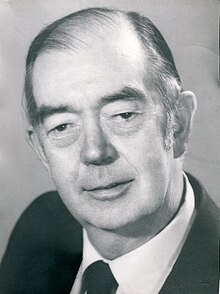 John Mills aged 60 in 1976 | |
| Born | 12 November 1916 Barnes, Surrey, England |
| Died | 6 May 1998 (aged 81) Malvern, Worcestershire, England |
| Alma mater | Kings College London |
| Spouse |
Pauline Phelps (m. 1950) |
| Children | Two sons |
| Awards | 1971 Fellow IEE (Now IET since 2006 ) |
| Scientific career | |
| Fields | Defence Scientist Specialist in: Radar, Military Communications and Navigation Systems |
| Institutions | AMRE, Dundee RAE, Farnbourough TRE, RRE, Malvern Min Tech, London SRDE, Christchurch RSRE, Malvern |
John Robert Mills (, FIEE), born November 12th 1916 and died May 6th 1998,[1] was a British physicist and scientific expert who played an important role in the development of Radar and the defence of Britain in World War II. After the war he continued his career working for various British government research establishments on a variety of projects until his retirement in 1977.[2]
In addition to many achievements and contributions to military technological development, Mills was the first British scientist to receive radio-wave signals bounced off the moon[3]
Education & Early Career
Following his education at the Kingston-upon-Thames Grammar School he gained a BSc in physics at Kings College London in 1939 (The start of WW2) and later the same year he joined the Air Ministry Research Establishment in Dundee. In 1940 he moved to the Royal Aircraft Establishment (RAE) at Farnborough and in 1942 moved to the Telecommunications Research Establishment (TRE) in Malvern which later became the Radar Research Establishment (RRE) and later still the Royal Radar Establishment (RRE) where he stayed until 1960.[2]
-
John Mills
aged 24 in 1940 -
John Mills
aged 28 in 1944
John Mills was part of a ground breaking group during the Second World War that established Radar as a both a meaningful defence, particularly against enemy aircraft, and guidance technology. This included air navigation systems and later as a member of the (Offensive) Airborne Radar Division at RRE, the development of infra-red radar targeting and reconnaissance systems for the Royal Air Force and Royal Navy.
The equipment developed for navigation, targeting and reconnaissance was further advanced for inclusion in the V bomber force and the TSR2 the most technically advanced aircraft of its era, as well as the development of the first successful sideways looking reconnaissance radar which was further developed by the USA and led, amongst other things, to today’s satellite radar systems.[2]
1960-1967
Mills spent about a year in London followed by five years at RAE as head of Radio Department where his responsibilities included:
- Electronic warfare systems,
- Very Low Frequency (VLF) navigation which led to the Omega system
- Radio propagation studies.
During this period his team received the first message bounced off the Moon from the USA, work which eventually led to modern satellite communications. He also worked in the development of the first automatic aircraft landing system.[2]
Mills was appointed Scientific Advisor to Tony Wedgewood-Benn (Minister of Technology) in 1966.[2]
1967–1976
From 1967 to 1976 Mills was the director of the Signals Research and Development Establishment (SRDE) in Christchurch, Dorset. During this period he was responsible for progress in three major technical areas:[2]
- Night vision devices, mainly for the Army in which image intensifier technology was exploited in equipment’s from rifle sights to systems for tanks and other vehicles.[2]
- Tactical and strategic radio and communication network systems some of which are still in use by the British Army[2]
- Military satellite communication systems with emphasis on light weight ground terminals for mobile use.[2]
-
John Mills
aged 54 in 1970 -
John Mills
with SRDE team in 1974
In 1971, Mills was appointed a Fellow of the Institution of Electrical Engineers (IEE), the highest grade of IEE membership.[4]
1976–1977
The final chapter in Mills's career in defence was a return to Malvern in 1976 as Deputy Director of the Royal Signals and Radar Establishment (RSRE) formed by moving SRDE to Malvern as part of the programme to rationalise the defence establishments. His team worked on advanced military and satellite communications. Mills held this post until his retirement in 1977.[2]
-
John Mills
aged 60 in 1976 -
John Mills with HM The Queen and
HRH The Duke of Edinburgh at RSRE in 1976
Publications
Mills contributed to an article on radar published in the Encyclopedia Britannica[3]
Mills published "Radio Techniques for Automatic Systems in the Air" in the Journal of Navigation in 1960[5]
Mills joint published "The Long-range Navigation of Civil Aircraft" in the Journal of Navigation in 1964[6]
Personal life
Mills married Pauline Phelps during his first spell at Malvern in 1950.[3] He was very much a family man with keen interests in music and gardening,[2] He was survived by his wife and two sons.[3]
References
- ^ "www.familysearch.org". Retrieved 20 September 2016.
- ^ a b c d e f g h i j k Slater, Kenneth (July 1998). "John Mills 1916-1998". Physics World (Inst of Physics). 11 (7): 41. ISSN 0953-8585.
- ^ a b c d "John Mills (Obituary)". Daily Telegraph. 17 July 1998. p. 29.
- ^ "Fellow (FIET)". IET. Retrieved 26 September 2016.
- ^ "Radio Techniques for Automatic Systems in the Air". The Journal of Navigation. 13 (1). Cambridge University Press: 47–58. doi:10.1017/S037346330003722X.
- ^ "The Long-range Navigation of Civil Aircraft". The Journal of Navigation. 17 (2). Cambridge University Press: 167–182. doi:10.1017/S0373463300048530.
Category:Radar pioneers
Category:English physicists
Category:British military engineers
Category:Military communications of the United Kingdom
Category:British people of World War II




